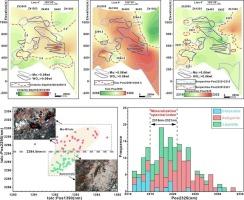Application of geological and shortwave infrared (SWIR) spectroscopy mapping in the Yechangping giant porphyry-skarn Mo-W deposit, East Qinling, China
IF 3.6
2区 地球科学
Q1 GEOLOGY
引用次数: 0
Abstract
The Yechangping deposit, located in the East Qinling Orogen belt, is a giant porphyry-skarn Mo-W deposit in China. This deposit features two spatially zoned alteration-mineralization systems: (1) porphyry-type assemblages and (2) magnesium (Mg)-skarn-type associations, with high-grade ore bodies predominantly hosted within Mg-skarn. Poor understanding of alteration-mineralization relationships has hindered exploration progress. This study employs shortwave infrared (SWIR) spectroscopy to map alteration minerals in Yechangping and evaluate its exploration potential. SWIR spectroscopic analysis identified multiple alteration mineral groups, including white mica (illite, muscovite and phengite), smectite (montmorillonite and saponite), kaolin (kaolinite and dickite), amphibole (hornblende, tremolite and actinolite), phlogopite, serpentine, talc, chlorite, carbonate minerals (dolomite, calcite and siderite) and sulfates (gypsum). White mica shows a strong spatial association with porphyry-related alteration and mineralization, whereas chlorite, talc, and serpentine are extensively developed within skarn zones and are closely linked to the formation of skarn-related ore. The Illite Spectral Maturity (ISM) values (>0.8) of white mica effectively map porphyry-related potassic and phyllic alteration zones, revealing the distribution of granitic porphyry and its adjacent magnesium skarn. High-grade Mo-W ore coincides spatially with retrograde magnesium skarn can be indicated by chlorite Depth2330/Depth2250 ratios (>2.0), talc Fe-OH absorption wavelengths (>2294.5 nm), and serpentine Mg-OH band ranges (2315–2321 nm). These mineralogical indices define vectors to mineralization centers. This study provides the first documentation of using SWIR spectral mapping in the exploration of porphyry-magnesium skarn Mo-W deposits.

地质及短波红外(SWIR)光谱填图在东秦岭叶昌坪巨型斑岩-矽卡岩型钼钨矿中的应用
叶昌坪矿床位于东秦岭造山带,是中国大型斑岩-矽卡岩型钼钨矿床。该矿床具有两个空间分带蚀变成矿系统:(1)斑岩型组合和(2)镁矽卡岩型组合,高品位矿体主要赋存于镁矽卡岩内。对蚀变—矿化关系认识不足,阻碍了勘探进展。利用短波红外(SWIR)光谱对叶昌坪蚀变矿物进行了制图,并对其找矿潜力进行了评价。SWIR光谱分析鉴定出多种蚀变矿物群,包括白云母(伊利石、白云母和白云母)、蒙脱石(蒙脱石和皂石)、高岭土(高岭石和硬石)、角闪石(角闪石、透闪石和放光石)、云母、蛇纹石、滑石、绿泥石、碳酸盐矿物(白云石、方解石和菱铁矿)和硫酸盐(石膏)。白色云母与斑岩相关蚀变和成矿具有较强的空间关联性,而绿泥石、滑石和蛇纹石在夕卡岩带内广泛发育,与夕卡岩相关矿石的形成有着密切的联系。白色云母的伊利石光谱成熟度(ISM)值(>0.8)有效映射了斑岩相关钾化和植物蚀变带,揭示了花岗斑岩及其邻近镁质夕卡岩的分布。绿泥石Depth2330/Depth2250比值(>2.0)、滑石Fe-OH吸收波长(>2294.5 nm)和蛇纹石Mg-OH波段范围(2315 ~ 2321 nm)表明高品位Mo-W矿在空间上与逆行的镁矽卡岩重合。这些矿物学指标定义了指向矿化中心的向量。本研究首次记录了利用SWIR光谱成图勘查斑岩镁矽卡岩型钼钨矿。
本文章由计算机程序翻译,如有差异,请以英文原文为准。
求助全文
约1分钟内获得全文
求助全文
来源期刊

Ore Geology Reviews
地学-地质学
CiteScore
6.50
自引率
27.30%
发文量
546
审稿时长
22.9 weeks
期刊介绍:
Ore Geology Reviews aims to familiarize all earth scientists with recent advances in a number of interconnected disciplines related to the study of, and search for, ore deposits. The reviews range from brief to longer contributions, but the journal preferentially publishes manuscripts that fill the niche between the commonly shorter journal articles and the comprehensive book coverages, and thus has a special appeal to many authors and readers.
 求助内容:
求助内容: 应助结果提醒方式:
应助结果提醒方式:


